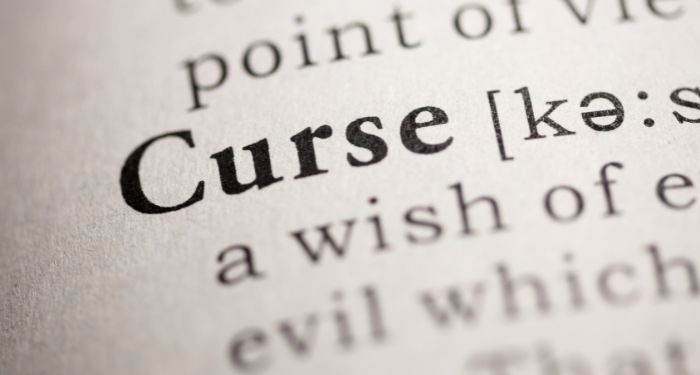
Read With Caution: A History of Book Curses
Whether books, as objects, have an intrinsic value irrespective of the merits of their contents is a question all of us modern readers have thought about at some point in our lives. I personally still find myself lugging books that I am never going to reread from one city to another or buying a book that I have already read because I spot a copy with a particularly nice cover.
The answer to this dilemma was unambiguous a few centuries ago. The physical book was indeed a sacred — and rare — object, a reality that is difficult for us to imagine at a time when we are spoilt with such an abundance of affordable reading material in various formats. Books in ancient and medieval times were treasured and protected with passion. Some of the earliest libraries even went as far as to chain the tomes in their collections to the shelves. The medieval guardians of books did not stop at just a physical deterrent to protect their precious charges. They also inscribed books and manuscripts with often detailed curses designed to strike fear in the hearts of potential book thieves.
Ancient Book Curses
The earliest known definitive example of a book curse comes from ancient Babylon. The library of Assyrian king Ashurbanipal, who ruled Babylon in the 7th century BCE, housed a large collection of clay tablets, and the following curse was inscribed on the tablets for their protection:
“The palace of Ashurbanipal, king of hosts, king of Assyria, who putteth his trust in the gods Ashur and Belir … I have transcribed upon tablets the noble products of the work of the scribe which none of the kings who had gone before me had learned, together with the wisdom of Nabu insofar as it existeth {in writing}. I have arranged them in classes, I have revised them and I have placed them in my palace, that I, even I, the ruler who knoweth the light of Ashur, the king of the gods, may read them. Whosoever shall carry off this tablet, er shall inscribe his name on it, side by side with mine own, may Ashur and Belic overthrow him in wrath and anger, and may they destroy his name and posterity in the land.”
From Anathema!: Medieval Scribes and the History of Book Curses by Marc Drogin
Medieval Book Curses
The book curse became popular in Europe in the medieval period, with Christian monasteries zealously collecting books for their libraries and employing scribes to create copies. Books were precious objects, both for the cost of raw materials as well as the fact that they had to be painstakingly written and copied by hand.
As Marc Drogin points out in Anathema!: Medieval Scribes and the History of Book Curses, the borrowing and lending of manuscripts was a very serious affair. Medieval scholars and collectors often went to great lengths to obtain error-free manuscripts to have them copied for their own collections. Writing was a very specialized skill, and scribes had the freedom to add their own messages to the beginning or the end of the books. They sometimes made sure to record how physically taxing it had been to copy the manuscript, entreating readers to wash their hands before they touched the fruits of their labor. Libraries in monasteries often formulated stringent rules for the handling of the manuscripts in their collections.
Book theft was a more serious crime in those times, and scribes started including a curse at the beginning or end of the book to deter people from stealing or damaging books. Most manuscripts in medieval Europe were religious texts, and the most common threat contained in these curses was the threat of excommunication or anathema. As the trend of book curses caught on, scribes copied from and improved upon the curses of those who came before them. The curses became more creative and graphic. In his book Anathema!, Drogin has collected an amusing selection of medieval book curses. Some, like this one, are straightforward:
“This book belongs to St. Alban. May whosoever steals it from him or destroys its title be anathema. Amen.”
Found in multiple manuscripts from St. Alban’s monastery, quoted in Anathema!: Medieval Scribes and the History of Book Curses by Marc Drogin
Others, like this one, are considerably more graphic:
“Book of [the Abbey of ] Saints Mary and Nicholas of Arnstein: If anyone take away this book, let him die the death; let him be fried in a pan: let the falling sickness and fever seize him; let him be broken on the wheel, and hanged. Amen.”
The Arnstein Bible, quoted in Anathema!: Medieval Scribes and the History of Book Curses by Marc Drogin
In a Middle Dutch natural encyclopedia and bestiary, the book curse takes the form of an oath where the borrower had to swear that they would return the book or die. In Drogin’s book, I came across a curse that was amusing in cursing not only the book thief but also anyone who dares to criticize the scribe’s work:
“If anyone steal it, let him be anathema!”
“Whoever finds fault with it, let him be accursed. Amen”
Paraphrased in Anathema!: Medieval Scribes and the History of Book Curses by Marc Drogin
While there is no way to be certain of the extent of the efficacy of book curses in preventing theft and damage, built-in book curses presented an awkward problem when books and manuscripts legitimately changed hands. When the bishop of Exeter in 1327 acquired a book with the following inscription:
“This book belongs to Sc. Mary of Robert’s Bridge; whoever steals it, or sells it. or takes it away from this house in any way, or injures it, let him be anathema-maranatha”
He felt the need to clarify below it:
“I, John, bishop of Exeter, do nor know where the said house is: I did not steal this book, but got it lawfully.”
From Anathema!: Medieval Scribes and the History of Book Curses by Marc Drogin
With the invention of the printing press and the subsequent reduction in the cost of production of books, the use of book curses dwindled but did not completely disappear. In a cookbook manuscript from the 17th century, the author threatens potential book thieves:
“Jean Gembel her book”
“I wish she may be drouned yt steals it from her”
Cookbook manuscript in the collection of New York Academy of Medicine
Even as book curses ceased to be a practical defense against theft, they were included playfully in children’s books, and children sometimes practiced their calligraphy by scribbling curses in the books they could get their hands on.
While we do not normally go around trying to fortify our beloved books with curses, we often cannot help our possessive urges and indulge in the satisfaction of the ex-libris. I remember some very aggressive declarations of ownership that I had scribbled onto some of my favorite books as a child, and a friend of mine had shown me a book she had inscribed as a child with specific instructions for her sister to stay away from it.
No matter where you stand on the books as a sacred object debate, there is a strong enough tradition of book curses for us to exercise caution when dealing with books. So, dear reader, return your library books on time, and don’t even think about using a piece of bacon or a used tissue as a bookmark.










